
East West Players has a long tradition of staging well known musicals which would normally feature “traditional” casting, shows like Stephen Sondheim’s Passion, Follies, A Funny Thing Happened On The Way To The Forum, and Sweeney Todd, and casting them with Asian actors who might under other circumstances be overlooked for the roles. This year, it’s Stephen (Wicked) Schwartz whose work is center stage, and the results are, as might be expected from EWP’s sterling track record, sensational.
This Pippin is particularly special because, unlike last year’s more traditional Sweeney Todd, East West’s latest musical offering has been given a distinctly Asian concept and look. Anime, martial arts, and Samurai dramas are integral to director Tim Dang’s imaginative staging, and make this Pippin unlike any other.
Schwartz’s 1972 Broadway smash (nearly 2000 performances) tells the story of Pippin (aka Pépin le Bref), son of the emperor Charlemagne (here called Charles), and his search for an extraordinary life. He tries war, he tries sex, he tries patricide in order to become king, and nothing makes him feel extraordinary … until he realizes that it really is the simple things, loving, and being loved, that make life meaningful.
Just as Europe had its feudal tradition, so did Japan. Thus, in Dang’s Pippin, Charles dresses and sounds just like a 8th century Samurai chief. There are frequent background projections of Samurai era paintings, and the warring soldiers use traditional martial arts moves in their combat. Add to this mix 21st century hip-hop beats and moves set to a dance club-ready soundtrack, and you have and idea of how different this Pippin is from any other.
Just a few of the contemporary and/or Asian touches:
•“Magic To Do,” the show’s opening number, re-orchestrated by musical director Marc Macalintal to hip-hop techno rhythms (as is Pippin’s rapped “Extraordinary”)
•“Glory,” a hymn to war, performed with martial arts moves, kicks, and jabs
•A break-dancing “On The Right Track”
•Grandma Berthe singing “No Time At All” while accompanied by a trio of shirtless hunks (not particularly “contemporary” or “Asian” but still worthy of mention)
The story of Pippin is told by a character known only as Leading Player. Entertainer extraordinaire Ben Vereen originated this role in a show-stopping tour de force performance full of show biz pizzazz. Here, Broadway’s Marcus Choi goes for a more low key approach, dressed in black trench coat and looking more like a seedy drug dealer than a showman. Choi’s performance takes off whenever he sings, and whenever he moves his dancer’s body to the hip-hop beats of DJ LinoType, spinning vinyl above the East West stage.
Broadway and West End vet Ethan Le Phong, fresh off the smash hit Mask, is Pippin, a role which offers the boyish and ingratiating golden-voiced performer the leading role which he so richly deserves. Awkward and earnest and utterly charming, Le Phong has the voice that Broadway original John Rubinstein lacked (oh if only someone would record a new Pippin on CD!), and when he raises it in “Corner Of The Sky” and “Morning Glow.” the result is something very special indeed. Even more extraordinary is that Le Phong learned this role in a week, yet displayed not a hint of nerves on opening night.
Dang has surrounded Le Phong with talent galore. As Charles, a forceful Mike Hagiwara looks like he stepped right out of Kurosawa’s Seven Samurai. Cesar Cipriano plays Pippin’s self involved half-brother Lewis. Possessing a torso of sculpted perfection, Cipriano is not just a pretty bod, but a talented singer and dancer, sizzling to Jason Tyler Chong’s sexy street dance moves. Jenn Aedo is hotness personified as Lewis’s sultry mother Fastrada, and sings a delicious “Spread A Little Sunshine.”
Gedde Watanabe (of Sixteen Candles fame) starred in East West’s A Funny Thing Happened To Me On The Way To The Forum, which Dang set in Polynesia. Here, the always scene-stealing Watanabe dons a woman’s kimono and geisha wig to portray Pippin’s octogenarian grandmother Berthe, the role originated by Irene (Beverly Hillbillies’ Granny) Ryan, scoring many laughs with his Japanese interjections and leading the audience in the infectious sing-along “No Time At All.”
Maegan McConnell adds oomph to Act 2 with her terrific performance as Catherine, the young widow who falls for Pippin from the moment she catches sight of his foot. McConnell, who seemed born to play Maria in the recent West Side Story, here proves herself a charming comedienne, all the while displaying the same glorious soprano in “Kind Of Woman” and her “Love Song” duet with Le Phong.
William Jay makes a cute Theo (Catherine’s son) and sings well in the post finale “Theo’s Corner.” The “dance crew” is made up of Kari Lee Cartwright, Ryyn Chua, co-choreographer Blythe Matsui, Mike Moh, and Chloe Stewart, and a more shapely, fit and fantastic bunch of dancers you won’t soon find.
Essential to Dang’s vision are the contributions of the design team, most especially Naomi Yoshida’s costumes (assisted by Paulette Uris) and Jackie Phillips’ hair and make up design. The costumes range from traditional Japanese kimonos to 21st century street punk to some very brief tighty whities worn by the dance crew boys. The men’s hair is spiked and gelled and the women all sport florescent multi- colored wigs. Alan E. Muraoka’s multilevel set offers the cast a strenuous workout as they climb up and down stairs, filling the stage from left to right and bottom to top. Even better are Muraoka’s projection designs which set the scene with Asian motifs, whether ancient paintings or ultra-modern anime images. Dan Weingarten’s lighting is as colorful and dramatic as the sets and costumes.
Musical accompaniment is provided by LinoType, conductor/musical director Macalintal on keyboards, and Vince Reyes on drums. The sounds they make are so huge, and often fully orchestral, that I have no idea how they made them, but the results are phenomenal.
If ever a “revisal” has featured completely innovative choreography, East West Players’ Pippin in the one. There are no traces of the signature Bob Fosse choreography (all hats and hands) of the original. Chong and Matsui’s collaboration on choreography is totally original, whether hip-hop or ballet. (There’s one particularly gorgeous moment where a male and female dancer perform only in silhouette projection behind lovers Pippin and Catherine.)
One caution. A bisexual orgy scene makes Pippin a no-no for children under a certain age but a definite yes-yes for more adventurous theatergoers.
There were a few technical glitches and occasional lack of tightness on opening night, but these are sure to vanish as the show continues its run. This Pippin is a must-see for any musical theater fan, and a perfect chance to see how a much performed show can gain fresh life when reconceived with imagination and ingenuity.
David Henry Hwang Theater, 120 Judge John Aiso St., Los Angeles.
www.eastwestplayers.org
–Steven Stanley
May 14, 2008
Photos: Michael Lamont

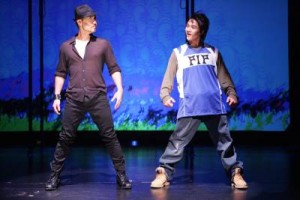
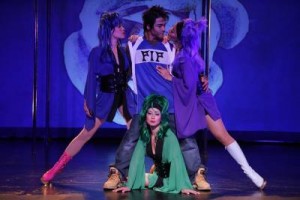
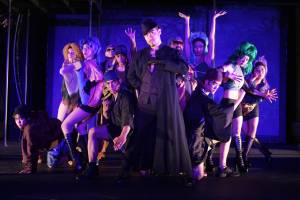
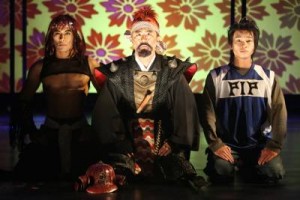
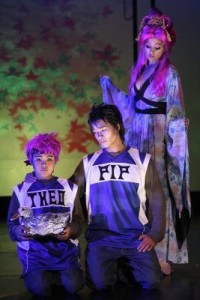

 Since 2007, Steven Stanley's StageSceneLA.com has spotlighted the best in Southern California theater via reviews, interviews, and its annual StageSceneLA Scenies.
Since 2007, Steven Stanley's StageSceneLA.com has spotlighted the best in Southern California theater via reviews, interviews, and its annual StageSceneLA Scenies.







 COPYRIGHT 2024 STEVEN STANLEY :: DESIGN BY
COPYRIGHT 2024 STEVEN STANLEY :: DESIGN BY